
Image taken from norfolk4families.co.uk
My first day at Norwich Castle began with a tour (led by our own Holly Bowers who also volunteers there) of the museum. We walked through several art exhibits, a section on wildlife and natural history, the torture chamber, and of course the castle keep. The museum has attractions for every generation, but its focus is primarily on young children. I found as I walked through that with the exception of the art exhibits, every room took a hands on approach. There were things for the children to touch and move around, making the experience fun and educational. The museum has a classroom for visiting schools and their own museum club programs. There is even a “picnic room” for the kids to eat their lunch in.

Image taken from myfinepix.co.uk
The rest of the day was filled with run of the mill office tasks like photocopying and preparations for the craft activities. The photocopies I made were put together in pamphlets to educate instructors about the museum club activities. They talked different approaches to teaching and learning and how the museum activities strives to foster that learning. They also provided several examples of sample lessons an instructor might try to incorporate into their activities.
The crafts were more fun to do – they reminded me of things I used to do in school and camp when I was a young child. One is an origami project, so Holly and I spent a lot of time folding paper. The other project we worked on was creating torques for their “Iron Age Day” out of wire.
Of course the coolest part of the entire experience was getting my own, all access, backstage pass, swipey card to the museum. We entered the museum through the employee only entrance and the security team fitted us out with identification badges and a key card that allows you entrance to all of the staff only doors. As you can imagine, I felt very important.
Date: 23/3/2011
Supervisor: Daniel Pounds
Time: 9:30-4, 6.5 hrs
Total Hours: 15.5
Tags: 2010 Sarah
September 21st, 2010 · No Comments
The way I feel about England’s museums (BM in particular) is the same way I feel about Tom Brady. They are both morally flawed, but too beautiful for me to honestly give a damn. So in that spirit lets forget about the mistreatment of Greece and Bridget Moynihan and just admire the physical beauty and inherent cultural value of the objects themselves. Sure, the jewelry collection in the Victoria and Albert represents the opulence, indulgence, and filthy wealth of the upper classes and royalty, but look how sparkly those diamonds are! The intricate cloisonne! The colorful enamel! The gemstones! Don’t hate the tiara because a spoiled rich woman owned it, admire it for its elegant design and exquisite craftsmanship.
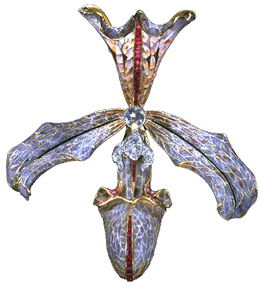
Hair ornament in the form of an orchid, made by Philippe Wolfers, Belgium, 1905-7. Museum no. M.11-1962. Image from the Victoria and Albert Museum website
I also must say, setting aside moral issues and countrys’ bruised egos, what is truly in the best interest of the objects themselves is for them to be left alone. Art and artifacts should be handled and moved as little as possible to avoid damage and the acceleration of deterioration. Professor Earenfight, who curates the Trout Gallery and teaches the museum studies course at Dickinson, likes to say that art and artifacts are like the elderly. They are set in their ways, used to their specific atmosphere, and the best thing for them is to disrupt their comfort as little as possible. The bottom line is, virtually all of the objects in London’s museums are priceless and definitely irreplaceable. The transportation of any of these objects across countries and continents is absolutely horrifying from an art conservation/curatorial point of view.
In any case, how great is it that we can get into all of these places for free? Sure, government subsidization lends itself to government censorship, but the fact that I can just wander in off the street, as I am, and walk right up to Jan van Eyck’s The Arnolfini Portrait, or Joseph Wright’s An Experiment on a Bird in the Air Pump, or the ship burial treasure from Sutton Hoo, or the Rosetta Stone and countless other treasures more than outweighs any negative aspects for me. London’s collections are among the finest in the world, and they are open to everyone. Now that’s beautiful.
Tags: 2010 Rachel
September 21st, 2010 · No Comments
The Brits pour money into their precious museums, further proof to my idea that the Brits hold their rich and storied history above all things in this fine country. The Museum of London is probably the best example; a simply laid out but large museum with easy access to the public and several treasured pieces of London history contained within its walls. Like the Museum of London, most museums are easily accessible and a majority of them are free to the public, however it seems like the museums they offer are catered to a good balance of Brits and tourists alike. While walking through a museum like the British Museum or the National Portrait Gallery, it is common to hear a slew of accents from every corner of the room. Italian, spanish, english, you name it, these people are in the museums. Of course this kind of museum experience can only come from the British government pouring tons of money into these places, making them into a piece of history themselves.
The history on display in the museums isn’t only that of the Brits, however. I am sure it took millions upon millions of dollars to acquire the historical objects contained in museums like the British museum. Perhaps this is a testament to not only the Brits appreciation of their own history, but also of the history of the world. London is without a doubt, one of the most international cities in the world. Tourists come from all over to see the sights and people from all corners of the globes live tucked away in various corners of London. All these points lead me to believe that Londoners also take great pride in acknowledging how they themselves are linked to international history and will pay big bucks for precious artifacts to be moved to their museums.
The museums themselves seem to operate like any other public establishment in the city of London. The feeling of being pushed around from queue to queue is ever present, even in a place like a museum. The result is that you kind of have to rush yourself from museums, or as a fellow classmate said in their blog recently you have to learn to “skim” museums. It took me ten minutes just to get a good view of the Rosetta Stone because of all the people crowding around, and everyone seems to have you on a two minute timer to have your look and then move on. Even in a place like the National Portrait Gallery, I got the feeling that if I spent too much time looking at a painting or sitting on a couch (the green leather was incredible) I was going to be the recipient of dirty looks from every direction. Despite being invisibly queued up in most sections of museums, there is usually enough to experience for you to get lost for days.
Overall, the museums are definitely a great aspect of London and I believe that the fact that they are subsidized is a very good thing. It keeps tourists coming and it keeps the English aware and proud of their history and their knowledge of others’. The museums of London helped me to appreciate (like a good Londoner) the value of a trip down history lane.
Tags: 2010 Benjamin
September 21st, 2010 · 1 Comment
I’m not much of a history freak, but I think museums are amazing. They serve as a unique interactive learning experience allowing us to actually see and absorb things that we wouldn’t obtain through a textbook or classroom lecture. Seeing artifacts and paintings brings history to life, and this method of learning is preferable by some people and especially for young children for the hands- on experience. It is really cool to be able to walk into a museum, and in London’s case for free, and see something that existed millions of years ago. I’ve always admired to determination of historians to seek the unknown, and figure out when and why something happened, and to openly share this information with the public.
One of my favorite museum trips was earlier on in the month when we visited the Museum of London. I always knew about the Romans, and read about the founding of London and Britain as an empire, but actually physically seeing everything connected all of the random pieces of information in my head. I enjoyed learning about early Roman life, and realizing that we learned cleanliness from them. The women made hair combs, nail clippers, and even tweezers that so closely resemble the beauty essentials women use today. I loved that each floor uncovered different eras of London’s history, which included industrialization, political and social movements, and even fashion.
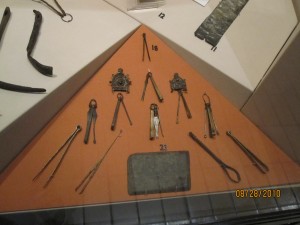
(Roman beauty essentials)
Another one of my favorite museums was the Victoria and Albert museum. Many students disliked this museum the most because it was too hard to navigate, but I actually appreciated the arbitrariness. I was so bored of visiting museums that solely displayed the rich white royalty of England, that is was nice to have a change with something that was completely informal and unplanned. Stumbling room by room through this organized chaos, I realized you could find just about anything in this museum. I was able to admire the fashion styles of Grace Kelly and to jealously look at centuries worth of jewelry worn by generations of rich people.
There were artifacts and sculptures thrown everywhere, it was like a giant garage sale. In the section with mosaics and paintings, we found a mosaic of Rome by Antonio Testa that took him twenty years to complete. This museum was filled with thousands of artifacts, my only question is where did they get all of this stuff from? I was trying to think of a coherent way that they could have organized everything, but honestly it would be impossible. So whether the designer just gave up on figuring out a floor plan, or intended it to be this way, I really enjoyed it.
Tags: 2010 Melissa · Uncategorized
September 21st, 2010 · 1 Comment
It seems like everyone I talked to in our program strongly disliked the Victoria and Albert Museum. I don’t know what they were thinking, because I thought it was one of the most amazing places I have ever been. I loved how random it was – it really epitomized British eccentricity. The V & A seemed to be completely lacking in order from one room to the next, whereas other museums that we have been to, like the British Museum or the London Museum seem to be arranged more logically. But I really like how chaotic it was. It added the element of surprise which made me laugh aloud. I think the key is to go in with a game plan. Know which exhibits you want to see beforehand, that way you organize your visit accordingly. Any interesting sites you find along the way can just be a fun little bonus.
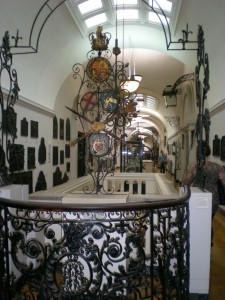
So what was the most interesting part of such a fascinatingly bizarre place? No, not the jewelry, although my eyes were glued to several dazzling tiaras, but what I found most intriguing was being able to watch the museum staff put together an exhibit. I felt like I was backstage at a play, watching the people who work behind the scenes. I never realized how much work it would take to create even just one exhibit. There were at least ten or fifteen people working on the room. Some were doing physical work, lifting and moving planks of wood, while others looked over papers on clipboards and directed traffic. However, I was a bit mystified because I didn’t know what it was exactly that they were building and I still don’t know what it had to do with that particular room of the museum. It just looked like they were plonking down a big ol’ wall in the middle of the room. And as far as I could tell there were no signs posted anywhere with “coming soon” information, so I’ll just have to make another trip back to London in a few months to see what it looks like.
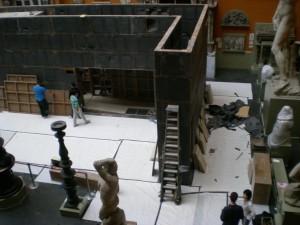
I also got really excited when I saw the piece by Dale Chihuly. The artist is known for his work with glass, creating huge and intricate structures. I was fortunate enough to be able to see his exhibit back home at the Botanical Gardens in New York with my family, and so when I recognized his work in the V&A, it was like seeing a little piece of home.

This is a piece at the Victoria and Albert Museum
Here’s one from home:
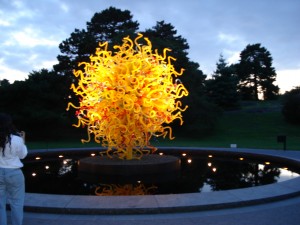
Tags: 2010 Sarah
September 20th, 2010 · 1 Comment
I’m a slow museum goer. I like to read all of the text as I go through, and when at an art museum, I tend to find a few paintings to focus on for, say fifteen minutes each, looking closely, and then backing up again, trying to discover the secret to the artist’s technique in the brushstrokes. And so I’ve found the process of visiting museums in London frustrating for the same reason that I’ve thoroughly enjoyed the experience: the collections at most of the museums I have visited here are just too expansive to see everything in a single afternoon.
The most extreme example is the Victoria and Albert Museum: each room is overwhelmingly full of objects, and almost every object is accompanied by a full paragraph of text. So fairly early in my visit there, I abandoned trying to read everything and even walked through some rooms without stopping, in order to use my time to really get a sense of the full extent of the museum. Not surprisingly, I really enjoyed the few exhibits were simpler, less cluttered, and more focused, such as the sequence of Peter Rabbit illustrations (which was a fun surprise). However, among the clutter I also stumbled on some amazing contemporary pottery within the Japanese exhibit, simply because it happened to catch my eye. In an entirely different part of the museum I saw some oil sketches by John Constable that looked surprisingly impressionist, compared to his typical, more realistic, complete landscape paintings. Over all, I was able to see plenty that I found interesting, despite skipping items and full exhibits along the way. However, the experience was somewhat stressful, since I knew that I had so little time to see so much.
In some of the art museums that showed mostly paintings I ended up needing to skim the collections as well. On my first visit to the National Gallery, I ended up looking at only the rooms that featured impressionist and post impressionist paintings since I love looking at paintings by these particular artists, and therefore spent a lot of time in front of each individual painting. (I discovered a new favorite Van Gogh painting, and a photo of it is attached to this post.) When I went back about a week later to see the rest of the museum, I still had to skip a lot of paintings and captions in order to get through see a variety. The skimming process inevitably led me to focus on finding the more famous paintings, such as Van Eyke’s Arnolfini Wedding Portrait and Hogarth’s Marriage A La Mode series, and although these were not all that I looked at, I wish I could have spent time looking at more of what the museum had to offer. It’s a strange trade off to be in a museum with a lot of amazing art, but to not get to see all of it because of the sheer quantity and quality throughout. My experience in the Tate Britain was similar, though to a lesser extent: there was an entire wing devoted to Turner paintings, many of which were truly breathtaking to look at, and I found it difficult to decide how to ration my time in order to move on to other parts of the museum.

Van Gogh painting (photo from National Gallery website)

Turner Painting (from Tate website)


The Sir John Soane Museum was an exception because it was much smaller than the other museums that I visited and included very little text. However, I had little access to information about what I was seeing, so I left feeling much less satisfied than when I left the larger museums. I definitely prefer a museum having too much on display that I want to see, rather than not enough. I still cannot figure out whether most museums in London are more text heavy than those in the States, or whether I just read very little of it here simply because there is so much to see. Either way, I think that I could return to a few of the museums that I visited every day for a week, and still have more left to discover there.
Tags: 2010 Emily · Uncategorized
September 20th, 2010 · 1 Comment
Rather than spend another post discussing curating practices or the pros and cons of government subsidies for museums, I wanted to write about the behavior I’ve observed in visitors to museums because, as a psychology major, this is what interests me. First, one can definitely tell the difference between English visitors to museums and tourists visiting museums. Tourists walk around looking up or looking sideways, gawking and paying no particular attention to where they are going. There was woman in the Map exhibit in the British Library yesterday who was wheeling around a suitcase behind her as she went through. Madam really, you are currently taking up enough space for three people. This doesn’t surprise me much, as I’m used to tourists in America being clueless and gawking as well. What I find more fascinating is the behavior of British visitors.
First, English visitors seem to come to museums with a specific purpose in mind. They seem to know exactly what they want to see and exactly what they want to learn or get out of their trip and proceed to the appropriate location efficiently. I’ll admit that it’s true that British visitors, especially Londoners, are at a bit more leisure to do this, since they live here and can return as often as they like while we tourists need to cram in as much as possible in a short period of time. In addition, some of these people are students with notebooks who must be on assignments concerning a certain painting or exhibit. An interesting mission that I’ve seen English museum visitors pursuing is educating a child. I’ve seen this several times, but I’ll share the example of a mother and son that I saw in the National Portrait Gallery. The mother had a notebook and was trying to convince the son (who seemed about 4 or 6 years old) to choose a picture he liked and try to draw it to “show Daddy later.” The son was reluctant and threw a few fits (as big of a fit as an English child would throw) but the mother was very persistent and kept telling her son, “We’ll look at just one more, one more picture.” When I saw them again later on, the son seemed a bit more engaged, but I just thought it was interesting that parents would bring their children to museums with such a structured purpose.
The second behavior that I’ve observed seems to relate to the English privacy rules and the social dis-ease mentioned by Kate Fox. I’ve noticed that if an English person is looking in a case or at a sign, and I walk up next to them to look at the same object, they will either apologize and leave, or give an embarrassed smile and leave. I still don’t really understand what they are apologizing for, but it’s almost like they think more than one person cannot occupy the same object (or 3 foot radius) as another person, like each person needs their time alone with whatever sign they are reading. I remember looking in the Museum of London at the Docklands at the hanging bird cage thing in which they would put pirates for birds to come eat them and a small child ran in front of me, pressing his nose on the glass, and asking his father to come look. The case was rather large, the print on the sign rather large, and the child rather short. He was not obstructing my view at all, but the father scolded him “Don’t stand there; the lady is trying to look.” I protested and said something like “Oh don’t worry he’s fine” to which the father gave an embarrassed laugh and quickly walked away. This behavior seems strange, awkward, and overly polite, but it makes some sense when we apply what we’ve read in Fox, and in light of other examples of social dis-ease that we’ve experienced in England. I suppose I prefer it to the behavior of American tourists, who will actually obstruct your view of something, and run you over with a suitcase while they’re at it.
Tags: 2010 Kaitlin
September 20th, 2010 · No Comments
I think it will be beating a dead horse at this point to talk about the lack of diversity in the National Portrait Gallery, but I guess I have to a little bit, so sorry horsey. Truthfully, the whole politically correct, inclusive way of thinking about representation is a late 20th century idea. Until that time, when the movement towards serious examination of who is telling/included in the historical narrative was underway, the rich white male’s story was the story, and if it was questioned, it wasn’t questioned openly. So, it was no surprise to me to see walls covered in portraits of the aristocracy and the very famous movers and shakers, and to see no portraits of the poor, lower classes, or racial minorities. (It’s important to note that portraits were mainly done by commission, and to sit for a portrait was time consuming. The lower classes wouldn’t have been able to afford or have the leisure time to have their portraits painted.)
I was, however, surprised by the number of portraits of women I saw. Still not as many as men, but much more than I was expecting. One portrait in particular that caught my attention was the self-portrait of Mary Beale.

Mary Beale, by Mary Beale, oil on canvas circa 1665 (Image from the National Portrait Gallery website)
I was immediately drawn to the richness and depth of the color (this is much more apparent in person). The draping of the Beale’s crimson and steely-plum silk dress suggests a solid, strong body beneath. Her expression is self-assured, yet humble, and she appears competent and adept. After admiring the painting for purely aesthetic reasons, I was even more interested when I read the accompanying text.
Beale worked as a professional painter from the mid-1650s, specializing in portraiture. She was the first Englishwoman to become a portrait painter of real distinction. A daughter of a Suffolk clergyman, by age 27 Beale was a very much in-demand portraitist, particularly for the clergy. Beale’s husband Charles, whom she married at age 19, was also a painter, and he acted as a studio assistant to Beale as well as kept records of all of her commissions. In the self-portrait above, a painter’s palette hangs on the wall in the background, referencing her profession, and she holds in her hand a canvas depicting her two sons, Bartholomew (1656-1709) and Charles (1660-1726).
It was so satisfying to see in the National Portrait Gallery a portrait of woman who was valued for something more than royal or aristocratic blood, or being a wife or mistress to someone of royal or aristocratic blood. How incredibly progressive, in the 17th century no less, for a woman to be honored and admired for her work as something other than being a madonna or a whore. To me, Mary Beale resembles quite closely the “ideal” modern woman. She was a wife and mother, but she was also a respected, talented, accomplished career woman, and that is what takes the historical precedence.
Reference:
Schubert, Gudrun. “Beale, Mary.” In The Oxford Companion to Western Art, edited by Hugh Brigstocke. Oxford Art Online, http://www.oxfordartonline.com/subscriber/article/opr/t118/e213 (accessed September 20, 2010).
Tags: 2010 Rachel
September 18th, 2010 · No Comments
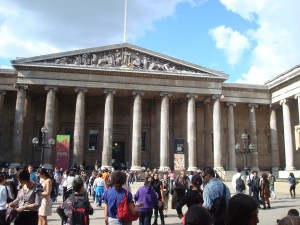
The museums of London seem to all fall around one dominant theme: imperialism. Seeing that this defined the British Empire for a majority of the last three centuries, it is no wonder that one can see its influence in each place one visits in London. Every museum either boasts the riches and plunders of the imperial era or makes some sort of comment on imperialism by what the curators chose and didn’t choose to include. As imperialism is, in my mind, the central idea around which all these museums exist, I’m going to take a look at each of the museums I have visited as reflections on the topic:
The British Museum: Many have already commented about the BM’s collection of artifacts and treasures from around the globe. It’s hard not to look at the mummies of ancient Egypt or the Elgin marbles without wondering just how exactly the BM got a hold of them. For its part, the museum seems to take delight in owning a collection that many would not consider rightfully theirs. On the “History of the World in 100 Objects,” I noted the quip the curator made about the “four languages” on the Rosetta Stone (as “Captured by the British Army” appears in English on the side of the artifact). While the BM could just ignore England’s imperial past, it seems to be content with making quips about where these objects came from. Essentially, the museum feels like a chance to show off the spoils of imperialism to rest of the world.

The Victoria and Albert Museum: This museum feels like a massive palace packed with valuables. In keeping with the British Museum, everything is thrown into areas based around vague “themes.” If you want to see jewelry, be prepared for a lot of rooms with a lot of randomly assorted riches. If you seek a certain historical artifact, you can probably find the right room based on the era and location of the piece, but after that you might have some problems as the rooms are randomly set up and gargantuan. Given the opulence of the collection, one cannot help but wonder how in the world the V&A wound up with all this stuff. The riches of imperialism are on full display at the V&A.
The Sir John Soane Museum: If the Victoria and Albert Museum feels like a massive palace packed with valuables obtained through imperialism, the Sir John Soane Museum IS a house packed with valuables obtained through imperialism. The place screams overkill, with walls of paintings that open up to more walls of paintings. I was particularly struck by the ivory chairs from India obtained during the eighteenth century: a very offsetting piece of the collection.
Natural History Museum: A few of us went through this museum after visiting the V&A, as the museum originated from the leftover collection at the V&A. While most of what one sees in the museum would not instantly recall British imperialism, some elements of the collection, like precious gems from South Africa, lead one to wonder just exactly how the museum got a hold of these pieces.
National Gallery: I really enjoyed this museum, but it is entirely Western European paintings. Given the Docklands Museum of London’s reference to the beauty of the arts in Africa before imperialism and slavery, why are none of these cultures, or those of the Middle East, represented?

National Portrait Gallery: I won’t go too much into this one, as several of my colleagues have already commented on the National Portrait Gallery’s imperialist nature. There is a stunning lack of racial or economic diversity in the collection, and I think a lot of that is a result of Britain’s imperialist past.
The Imperial War Museum: For a museum with the word “imperial” in the title, this museum actually had some of the least evidence of Britain’s imperial past of any of the places we visited. Only part of one wall was dedicated to all of the events surrounding the colonization of Africa, and I cannot recall any of the exhibits examining the struggles and fights for independence in any other former part of the British Empire. It is almost as if the curators wanted to sweep the entire history of British imperialism under the rug to focus on the glories of WWI and WWII. Based on the exhibits, one could easily come to conclusion that the Britain is embarrassed of its complete history. It was a cool museum, and I loved the section on British espionage (Who can’t love an exhibit that begins with James Bond clips?), but I found the museum incomplete because it ignored England’s imperial past.
The Cabinet War Rooms/Churchill Museum: My personal vote as the coolest museum in London, the Cabinet War Rooms show Britain near the end of the era of imperialism. Given the museum’s narrow focus, looking just at Churchill’s life and the struggle of the War Cabinet during the WWII Blitz, there was not much focus given to imperialism. One section of the Churchill Museum commented on the prime minister’s stance, early in his political career, in opposition to Indian independence. The part of the exhibit took a very apologetic tone, acknowledging Churchill’s mistake in taking such a position. Considering this museum is run in conjunction with the Imperial Museum, this part of the exhibit may provide an insight into the mind of the curators at that museum. Clearly, there is some sense of remorse on the part of the curators, evidenced by the Churchill Museum, for the British Empire’s actions, which could explain the lack of information about such events in the Imperial War Museum. Perhaps the curators are too ashamed to even broach the subject of British Imperialism.
Based on my observations, every museum I’ve seen in London is either indebted to imperialism due its bountiful collection of artifacts, or it tries to comment on the British Empire’s imperial past, typically by covering it up. Fifty years after the fall of imperialism, which is not that long ago, we still see its effects on the city of London.
Tags: 2010 Andrew
September 15th, 2010 · 2 Comments
Unless you have previous knowledge of the museum beforehand, the John Soane Museum will initially confuse you. Expecting to see another massive and imposing building, the Soane Museum is actually just an inconspicuous house located amidst the London city chaos. Without much of an introduction, I wandered inside holding my purse in a clear plastic bag—the reason for which I learned later on—immediately into Sir John Soane’s past. I wandered through the intricate maze of tall and narrow doorways and winding staircases, coming across only a small number of plaques describing Soane and his belongings. I gradually learned he was an English architect, remembered most for his remarkable skill and his design of the Bank of England.
John Soane’s house was incredible. The detail in the architecture was intricate and the colors and designs were nuanced and distinct. Besides the building itself, the objects it housed seemed for the most part entirely out of place. For example, a large open room, extending from a stone basement to a glass roof, exhibits a myriad of ancient Greek stone architectural pieces. Apparently the room is intended for students to wander through feeling as if in Greece while learning about the architecture. Although I appreciated the museum by the end of my personal tour, I could compare it to another museum I visited in Boston and did not enjoy it nearly as much.
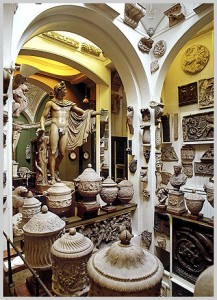
Greek Architecture Exhibit, John Soane Museum
The Isabella Stewart Gardner Museum in Boston, Massachusetts is similar to the John Soane Museum in that it’s a personal home that displays the past owner’s invaluable possessions. Isabella Gardner was not an architect like Soane, but rather a remarkable art collector, patron of the arts, and philanthropist. Unlike the Soane Museum, the Gardner Museum offered a tour as soon as the visitor entered—something vital when there’s an apparent lack of plaques, brochures, and audio guides. Furthermore, the organization and presentation of the pieces in the Gardner Museum was more effective. Instead of a disorganized jumble, Gardner’s rooms centralized the visitors’ focus on one main piece and designed the rest of the art in the room to reflect and elaborate on the piece’s expression. For example, one room displays a striking, passionate sort of painting, while other sculptures, drawings, plants, and the room’s decoration further emulate the painting’s dark, mysterious emotions.

Painting in Isabella Stewart Gardner Museum
In the end, I enjoyed the John Soane Museum as an exploration of one man’s architectural talent and creativity, the rare objects he collected, and his life in 18th and 19th century England. However, it became a challenge when I compared it to another somewhat similar museum that I much preferred over the Soane.
Tags: 2010 Mary · Museums


















